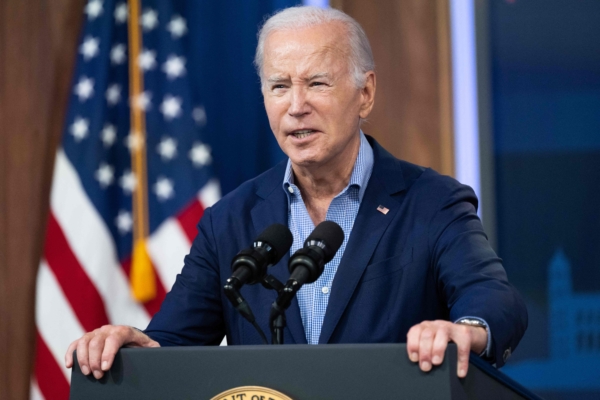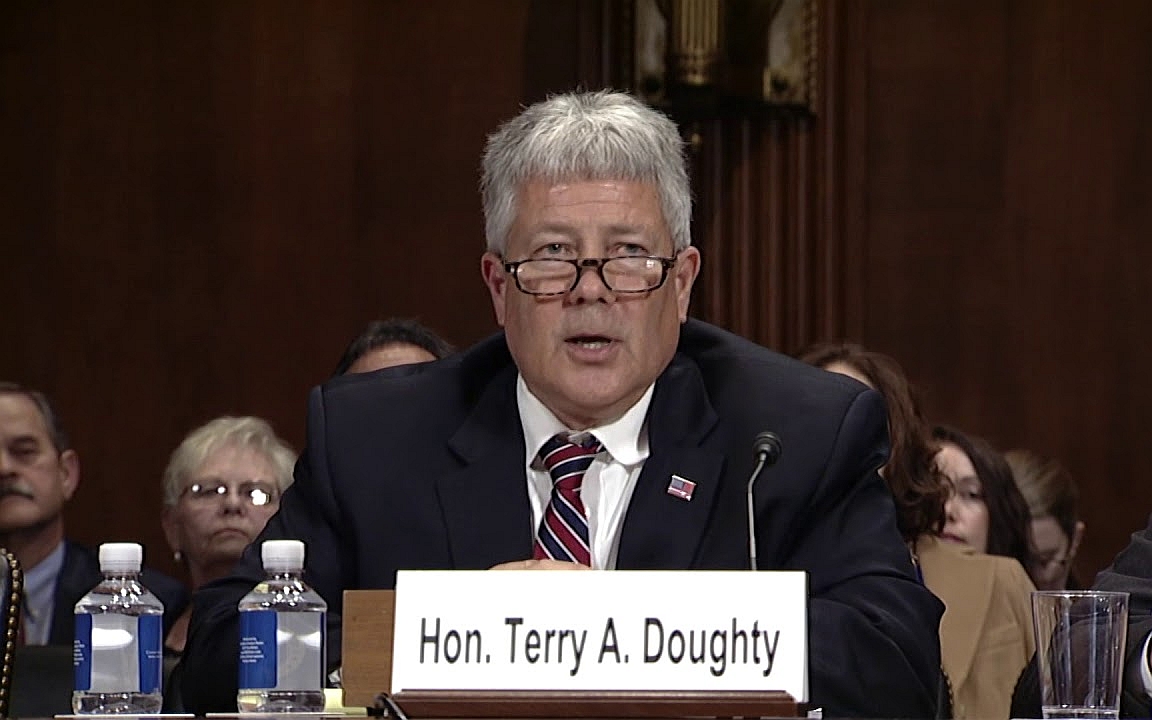On July 4, 11 federal agencies and dozens of their officials were legally blocked from further interaction with more than 20 social media companies about the censoring of information deemed by the government as misinformation.
Communication about criminal activity, national security threats, attempted foreign influence, cyberattacks, illegal campaign contributions, and voter suppression are exempt from the ban.
The preliminary injunction and temporary restraining order were issued by Judge Terry Doughty, a Trump appointee, in the U.S. District Court of Western Louisiana.
Greatest Attack Ever on Free Speech in America
In an accompanying 155-page memorandum, Judge Doughty framed the importance of his action.
“If the allegations made by the Plaintiffs are true, the present case arguably involves the most massive attack against free speech in United States’ history,” he wrote.
In his decision, Judge Doughty agreed with the plaintiffs that the harm is ongoing and likely to continue into the 2024 election and beyond.
Judge Doughty said the alleged actions of the federal government “blatantly ignored the First Amendment rights to free speech.”
Beyond Party Lines
He also said that though the “censorship alleged in this case almost exclusively targeted conservative speech, the issues raised herein go beyond party lines.”
Some of the conservative free speech that was shown to be suppressed included the integrity of the 2020 presidential election; the security of mail-in voting; the Hunter Biden laptop story prior to the 2020 election; the lab-leak theory about the origins of the COVID-19 virus; the effectiveness of masks, lockdowns, and vaccines; criticism of President Joe Biden; parody posts poking fun at administration officials; and negative comments about the economy, according to the complaint.

The judgment was handed down in a case called State of Missouri, et al., versus Joseph R. Biden Jr. et al., in which the states of Missouri and Louisiana and a group of individuals sued the executive branch of the federal government for violating their First Amendment right to speak and listen.
The Biggest Suppressors
The court order specifically enjoined the Executive Office of the President, the Department of Justice (DOJ), the Federal Bureau of Investigation (FBI), the Cybersecurity and Infrastructure Security Agency (CISA), the Department of Homeland Security (DHS), the National Institute of Allergy and Infectious Diseases (NIAID), the Centers for Disease Control and Prevention (CDC), Surgeon General Vivek H. Murthy, and other agencies along with their employees.
The defendants were ordered to refrain from either “coercing” or “significantly encouraging” the nation’s leading social media platforms to censor protected speech.
The plaintiffs in the case presented the court with documents that allegedly show that in 2019, the FBI investigated and flagged 929,000 political speech tweets by American citizens as “domestic disinformation” and sent them on to social media companies for evaluation and possible censoring.
Judge Doughty’s memorandum cites the testimony of FBI Special Agent Elvis Chan who said that in 2019 Twitter took down 422 accounts over 929,000 tweets.
“All political speech is protected speech,” Judge Doughty noted of the U.S. Constitution.
The social media companies involved in the government-directed censoring included Facebook/Meta, Twitter, YouTube/Google, Instagram, TikTok, Linkedin, and others.
None of the social media firms were named as defendants in the case or were parties to the injunction.
Strong-Arm Tactics
According to the memorandum, the plaintiffs allege that the defendants used public pressure campaigns, regular private meetings, and other forms of communication to “collude with and/or coerce” social media platforms to suppress the government’s disfavored speakers, viewpoints, and content.
The plaintiffs also argue that government officials used as leverage possible increased anti-trust scrutiny, additional regulations, and changes to Section 230 of the Decency in Communications Act to prompt social media companies to increase efforts to meet the censorship demands.
Section 230 grants social media platforms immunity from civil liability in suits brought against posters over the content of their postings.
Convincing Evidence
In the first 80 pages of the memorandum, the judge reviewed a portion of the voluminous evidence provided by the plaintiffs that convinced him to issue the injunction.
Much of the evidence goes back to the days of the COVID-19 pandemic, the 2020 presidential election, and the 2022 midterms.
Judge Doughty cited scores of specific proofs in the form of depositions, emails, letters, documents, and public statements by government officials that contained their exact words and those of the social media companies with whom they communicated.
An example of the evidence that convinced the court to issue the injunction reveals that, from May 28 to July 10, 2021, a senior Meta executive reportedly copied former Whitehouse senior COVID-19 advisor Andrew Slavitt on his emails to Surgeon General Murthy alerting them that Meta was engaging in censorship of COVID-19 misinformation according to the “White House’s requests” and indicated that “expanded penalties” for individual Facebook accounts that share the deemed misinformation were in the works.
Meta also stated, “We think there is considerably more we can do in partnership with you and your team to drive behavior.”
Another example of the close cooperation between social media firms and the White House highlighted by Judge Doughty’s memorandum was the reading in pertinent part, “On February 7, 2021, Twitter sent Flaherty a ‘Twitter’s Partner Support Portal’ for expedited review of flagging for censorship … Twitter also stated that it had been ‘recently bombarded’ with censorship requests from the White House and would prefer to have a streamlined process.”
Rob Flaherty is the White House’s former deputy assistant to the president and director of digital strategy.
Following Up on Requests
Mr. Flaherty is documented as having followed up frequently with social media platforms on how they were meeting the White House’s requests.
The following is an example of Facebook’s response to similar oversight and pressure.
“We obviously have work to do to gain your trust … We are working to get you useful information that’s on the level. That’s my job and I take it seriously—I’ll continue to do it to the best of my ability, and I’ll expect you to hold me accountable.”
Referring to the White House’s dissatisfaction with Facebook, Judge Doughty’s memorandum continues, “Slavitt … added more pressure by stating, ‘internally, we have been considering our options on what to do about it.’”
According to documents cited in the memorandum, in June 2022, the White House asked social media platforms to do more to censor so-called misinformation “regarding climate change, gender discussions, abortion, and economic policy.”
Upset about social media companies allowing what the Biden administration considered misinformation and disinformation about climate change to spread, White House National Climate Advisor Gina McCarthy “explicitly tied these censorship demands with threats of adverse legislation regarding the Communications Decency Act,” according to the evidence.
Also in June 2022, Biden’s White House formed a task force to stamp out so-called general misinformation and disinformation about women and LGBT individuals who are public and political figures, government officials, civic leaders, activists, and journalists.
In a memo discussing the creation of the task force and its relationship with social media platforms, threats of adverse legal consequences were again made if the tech firms did not censor aggressively enough.
Judge Doughty’s memorandum also listed some of the techniques employed by social media platforms to censor protected speech. They included changing algorithms to avoid amplifying the misinformation; the early detection of misinformation “super-spreaders;” building “frictions” to reduce the sharing of misinformation; search diversions; suspensions; and permanent de-platforming.
Role of CISA
CISA meets regularly with social media platforms, according to the plaintiffs.
CISA has a unit called the “Mis Dis and Malinformation Team” (MDM). Prior to the Biden administration taking office, the team was the Countering Foreign Influence Task Force.
During 2020, what is now MDM engaged in “switchboarding,” which is a disinformation reporting system run by CISA designed to allow state and local election officials to identify so-called misinformation involving their jurisdiction. Once the information is identified, CISA then passes it on to social media companies.
CISA also funds a non-profit organization called the Center for Internet Security (CIS), which does the same job as MDM but is considered a non-governmental organization.
In addition, CISA began working with a non-profit coalition called the Election Integrity Partnership (EIP), which also does the same job as MDM.
EIP also began to target political partisans with large internet followings who were allegedly spreading misinformation.
CISA, CIS, and EIP share intelligence between themselves.
According to Renee DiResta of the Stanford University Internet Observatory and member of CISA’s Cybersecurity Advisory Committee, the EIP was designed to get around “very real First Amendment questions that would arise if CISA or other government agencies were to monitor and flag information for censorship on social media.”
Private Entities Do Dirty Work
In his order, Judge Doughty wrote, “A state may not induce private persons to accomplish what it is constitutionally forbidden to accomplish.”
In oral arguments on May 26, the defendants’ attorneys argued that the EIP operated independently of any government agency.
Judge Doughty disagreed, writing in his legal analysis, “The evidence shows otherwise.”
He found that the CISA defendants, as well as all the others “likely jointly participated” with the social media companies with whom they have become “pervasively entwined.” This government involvement in the private companies’ workings has “blurred” the line between public and private action, Doughty said.
The Stanford University Internet Observatory and the University of Washington are two members of the EIP.
Effective ‘Thought Policing’
An example of the kind of posts flagged by CISA and its affiliates as so-called misinformation is a post that claimed, “mail-in voting is insecure” and that “conspiracy theories about election fraud are hard to discount.”
According to the plaintiff’s filings, CISA announced it intends to expand its fight against such so-called disinformation in the 2024 election.
CISA Director Jen Easterly said, “We are in the business of protecting critical infrastructure and the most critical is our ‘cognitive infrastructure.’”
According to EIP, all the major platforms significantly changed procedures and policies in order to slow the dissemination of bogus election-related narratives in 2020.
The non-profit saw 35 percent of the postings it referred to the platforms for censoring acted upon, the pleadings said.
In the EIP’s assessment, Internet influencers on the political right spread the most false or misleading information and most of the repeat offenders were supporters of then-President Donald Trump.
Centralized Censorship
The plaintiffs cite the Virality Project (VP) as another non-governmental group dedicated to increased censorship.
The VP has recommended that the federal government create a Misinformation and Disinformation Center of Excellence as a way of centralizing censorship expertise.

Doughty’s decision concluded, “The Plaintiffs are likely to succeed on the merits of their claims that the United States Government, through the White House and numerous federal agencies, pressured and encouraged social media companies to suppress free speech.”
The judge listed 22 examples of alleged coercion exercised by the White House.
“This seemingly unrelenting pressure by Defendants had the intended result of suppressing millions of protected speech postings by American citizens,” Judge Doughty wrote.
“The White House Defendants made it very clear to social-media companies what they wanted suppressed and what they wanted amplified … The ‘misinformation’ to be suppressed was whatever the government deemed misinformation.
“What is really telling is that virtually all of the free speech suppressed was conservative free speech … The targeting of conservative speech indicates the Defendants may have engaged in ‘viewpoint discrimination.’”
Free Speech, Free Thought Upheld
“(The government) became ‘partners’ with social-media platforms, flagging and reporting statements on social media Defendants deemed false,” the judge added.
“Each United States citizen has the right to decide for himself or herself what is true and what is false. The Government … does not have the right to determine the truth …”
Missouri and Louisiana filed the suit on May 5, 2022, and were joined by the individual plaintiffs on Aug. 2, 2022.
The preliminary injunction order, which the court deemed “in the public interest,” will remain in effect until the case is resolved by further order of the court or by the Court of Appeals or the U. S. Supreme Court.
The DOJ has already announced its intention to appeal.

















































